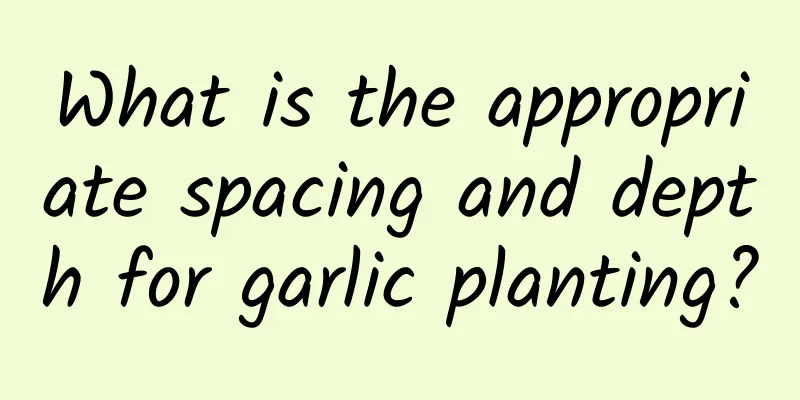What is the appropriate spacing and depth for garlic planting?

|
In garlic production, reasonable density planting is the basis for high-yield and high-quality garlic cultivation. If the row-to-plant spacing is too large, the yield of a single plant will be high, but the total yield will be low and the efficiency will be low. If the row-to-plant spacing is too small, the yield of a single plant will be low, the commercial quality will be poor and the selling price will be low. Different cultivation methods and cultivation purposes correspond to different optimal plant spacings, which can be specifically divided into the following three types: Row spacing for open-field garlic cultivationFor open-field cultivated garlic, the row spacing should be 20 cm and the plant spacing should be 7-8 cm. The number of plants planted per mu is about 45,000, and the seed rate per mu is about 225 kg. Open-field cultivation is divided into autumn sowing and spring sowing. Autumn sowing garlic has a long growing period and a relatively high yield level. On the premise that the row spacing remains unchanged, the plant spacing can be appropriately increased to ensure that each plant obtains a better yield, which is conducive to improving quality. The growing period of open-field spring sowing is relatively short and the yield per plant is relatively small. Higher field yields can be obtained through appropriate dense planting. Open-field autumn sowing is the main form of high-yield garlic cultivation, and it is also the most commonly used sowing method in major garlic producing areas such as Henan, Shandong and Hebei. In the high-altitude and cold regions in the north, garlic seedlings can easily be frozen to death due to low temperatures in winter. For the sake of planting safety, spring sowing is generally adopted. But whether it is autumn sowing or spring sowing, the sowing density can be appropriately increased in plots with sufficient soil fertility , while the sowing density should be appropriately reduced for plots with insufficient soil fertility . Plant spacing of garlic in film-covered cultivationThe row spacing of garlic cultivated under film mulch should be 20cm, and the plant spacing should be 9-10cm. The seedling quantity per mu is about 35,000 plants, and the seed quantity per mu is about 175kg. Garlic film mulching cultivation is used in both autumn-sown and spring-sown garlic, among which autumn-sown garlic is the most common. Due to the advantages of mulch in raising ground temperature, maintaining soil moisture, preventing pests, increasing root mass and improving fertility effectiveness. We can increase the yield of single garlic bulbs and garlic scapes by about 30-40% , which significantly improves the efficiency of high-yield and high-efficiency cultivation. The increase in the yield of garlic sprouts and garlic bulbs requires the root system to absorb nutrients and water in a larger range. The leaves above the ground also need more space to meet the needs of leaf growth and development. This also lays the foundation for the leaves to fully receive light and meet the photosynthetic products required for the plant's higher yield. If the spacing between rows and plants in film-covered cultivation is not increased appropriately, competition will arise between adjacent plants for water, fertilizer, and light absorption. It is not conducive to increasing the yield of each plant and improving the quality. The yield level and quality grade of film mulching cultivation will also be reduced, and the significance of film mulching cultivation will be discounted. Garlic row spacing for single garlic cultivationFor garlic cultivation with the purpose of producing single-headed garlic, the row spacing should be maintained at 15cm, and the plant spacing should be maintained at 5-6cm. The seedling quantity per mu is about 80,000 plants. The garlic seeds for producing single-headed garlic are smaller, and the seed quantity per mu is about 280kg. The yield of single-headed garlic is low, but the selling price is about 4 times that of multi-clove garlic, and the cultivation efficiency is higher. A key to the success of single-head garlic cultivation lies in the proportion of single-head garlic. If single-head garlic cannot be formed, the volume of the garlic produced will be significantly smaller due to the small size of the garlic cloves sown, and it is often a substandard product with very low commercial value. Through reasonable close planting, the sown garlic cloves will compete for nutrients, water and light during the growth process, causing their own nutritional supply level to be in a relatively deficient state. Under this condition, the differentiation of the bulb will be inhibited, resulting in an increase in the proportion of bulbs that cannot differentiate normally, thereby increasing the proportion of single-headed garlic formation. Garlic Planting DepthMany farmers may not care much about the most appropriate depth for planting garlic, but it directly affects the yield. There is a saying in the countryside that goes "deep planting of onions, shallow planting of garlic", which needs to be mastered. Generally speaking, the depth should be 4-5 cm. If the seeds are planted too deep, the temperature under the soil will be low during sowing, which will not only cause the seeds to germinate late, but also form weak seedlings after germination, ultimately leading to reduced yields. However, since the sown garlic cloves are close to the ground, when they turn green in the spring of the following year, you should pay attention to combining inter-tillage with appropriate soil cultivation to prevent the garlic from "jumping" and affecting the quality. |
Recommend
Does the money tree bloom? What does the flower look like?
1. Will it bloom? The money tree blooms. As a pla...
Yacon Origin, Yacon Price
1. Origin It is a perennial herb of the Asteracea...
How to make corn seeds germinate quickly? What is the germination temperature of seeds?
Corn seeds germination Corn is a short-day plant....
The 16 laws of the succulent circle
Broken Window Effect/Residual Meat Effect If the ...
How many years does the red pepper bear fruit?
Introduction to Planting Red Pepper Red robe pepp...
What are the cultivation methods and precautions of big green radish
How to grow green radish The big green radish, al...
Hibiscus Pest Control
Hibiscus aphid Aphids are one of the most common ...
How to cultivate red plum in potted plants
1. Control watering There is no definite rule for...
Can Cineraria be placed indoors?
1. Can it be put Here the editor wants to tell yo...
Add 1 spoon of sugar to water and use it to water the flowers, and the plants will grow continuously!
Don’t worry, today Huahua will share with you a l...
What temperature is best for watering garlic during the winter?
When planting garlic , if you want to know whethe...
Cultivation methods and precautions of colored leaf taro
Colored taro is very easy to grow. May to Septemb...
How to make rice water fertilizer
1. Production method 1. Put the water used to was...
The difference between Mirabilis jalapa and tuberose
1. Different appearance Mirabilis jalapa: Its roo...
The efficacy and function of winter melon
1. Relieve constipation Wax gourd is rich in plan...









